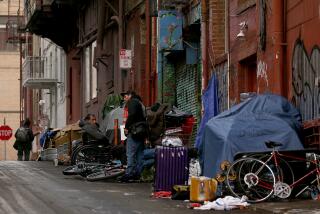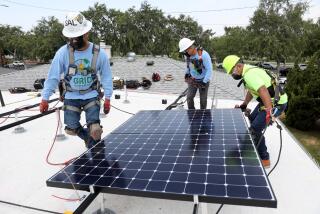Column: Newsom tries to have it both ways on fighting climate change and California’s housing shortage

Top priorities often conflict. Enjoy a vacation or advance at work? Save money for retirement or your kids’ college education?
It’s hard sometimes to have it both ways. The same goes with a governor when his policies compete.
Gov. Gavin Newsom is caught between two top priorities, although he doesn’t acknowledge it. He’s trying to be a global leader on climate change. But he has also promised to build more housing. He has elegantly articulated the need for both saving the planet and providing affordable places for Californians to live.
But some stuff he’s proposing to combat global warming would make it even tougher to build new housing in high-cost California.
He has placed these competing agenda items in the Legislature’s lap during the final days of its two-year session.
Newsom is pushing hard behind the scenes for a package of ambitious proposals that would accelerate the state’s climate and energy goals.
Many lawmakers are privately perturbed that he waited until the last minute of the session, which ends Aug. 31. They justifiably complain that there isn’t adequate time to study the proposals’ impacts, including on housing.
His ideas have also lacked details. As of Friday, they still weren’t in bill form and didn’t have legislative authors.
“We’re taking all of these major actions now in the most aggressive push on climate this state has ever seen because later is too late,” Newsom said in announcing his proposals Aug. 12.
True, the actions would be major, even groundbreaking. But the governor hyperbolizes in claiming they’d be the state’s “most aggressive push” ever on climate. I’d award that distinction to the landmark 2006 legislation signed by Gov. Arnold Schwarzenegger that launched California’s nation-leading attack on global warming.
Gov. Newsom urged lawmakers to harden the state’s climate and energy goals, releasing a five-point legislative plan that promises to intensify his clash with the state’s powerful, billion-dollar oil industry.
But exaggeration and embellishment by a politician shouldn’t shock anyone.
Newsom added that the impact of his proposals “will spread far beyond our borders. California will continue blazing a trail for America and the rest of the world on the swift and meaningful actions necessary for cutting carbon pollution, protecting communities and leading the clean energy future.”
Of late, Newsom has been blazing his own trail toward more national prominence, moving into better position — intentionally or not — to run for president if the opportunity arrives.
“He’s trying to rush everything through [the Legislature] and then he’s going to take it and go national. That’s what this is about,” asserts California Business Roundtable President Rob Lapsley, a veteran of Capitol politics.
Back to public policy.
One thing Newsom wants to do is codify into law the state’s goal of carbon neutrality by 2045. That would make it legally binding. Now it’s essentially a guideline in an executive order signed by former Gov. Jerry Brown.
Gov. Gavin Newsom’s single-tunnel proposal is more respectful of the estuary’s farms, habitat, boating and communities, columnist George Skelton writes.
Newsom also wants to adopt a more aggressive limit on greenhouse gas emissions. The current goal is 40% below the 1990 level by 2030. His legislation would move that target to 55%.
And to ensure that 100% of California’s electricity is noncarbon by 2045 — a current goal — he wants to set interim targets of 90% by 2035 and 95% by 2040.
Those actions would affect housing development in at least two ways:
First, it would jack up building costs with requirements that dwellings include such climate-fighting tools as rooftop solar, heat pumps and storage batteries.
Dan Dunmoyer, who heads the California Building Industry Assn., estimates a “very conservative minimum” additional cost per house of $50,000.
Second, it would provide a project’s opponents with more solid legal ground to file lawsuits under the oft-abused California Environmental Quality Act.
CEQA has hindered home building for many years, and it could be an even more deadly weapon for anti-housing factions if some Newsom proposals become law.
Gov. Ronald Reagan signed the law in 1970. It requires developers to undergo a lengthy process of analyzing a project’s environmental effects and reducing their negative impacts. It deserves credit for helping to clean the air, keep water pure and prevent developers from building on fragile earthquake faults.
But CEQA has also been blatantly abused. Union blackmailers — “greenmailers” — threaten to file environmental suits and derail projects unless developers cave to labor demands. Business rivals try to drive off potential competitors by filing suits that wear down investors. NIMBYs — “not in my backyard” — fight local projects that crowd their spaces or block views.
These costly suits can drag on forever, causing developers to cut their losses and abandon the projects.
Only 13% of CEQA lawsuits in 2020 were filed by genuine environmental groups, according to a study released last week by the California Business Roundtable.
Longtime developers’ attorney Jennifer Hernandez of Berkeley, who prepared the report, found that nearly half of new housing units were targeted by CEQA lawsuits.
And plaintiffs have discovered a new hook: alleging that projects don’t comply with climate policies set by the California Air Resources Board, whose influence would grow under Newsom’s proposed legislation. Hernandez cites CARB data that show two-thirds of CEQA suits allege noncompliance with limits on greenhouse gas emissions and vehicle traffic.
There has been “an explosion” of such suits, Hernandez says. “Climate impact is an incredibly potent CEQA litigation tool.”
The Newsom administration says California needs to build 2.5 million homes over the next eight years — 312,500 units per year. But over the last decade, we’ve averaged only about 100,000 annually, one-third of what’s needed.
Yes, we also must lead on global warming.
It’s a conflict of monumental priorities that probably can’t be wisely resolved in a few days.
More to Read
Toward a more sustainable California
Get Boiling Point, our newsletter exploring climate change, energy and the environment, and become part of the conversation — and the solution.
You may occasionally receive promotional content from the Los Angeles Times.









